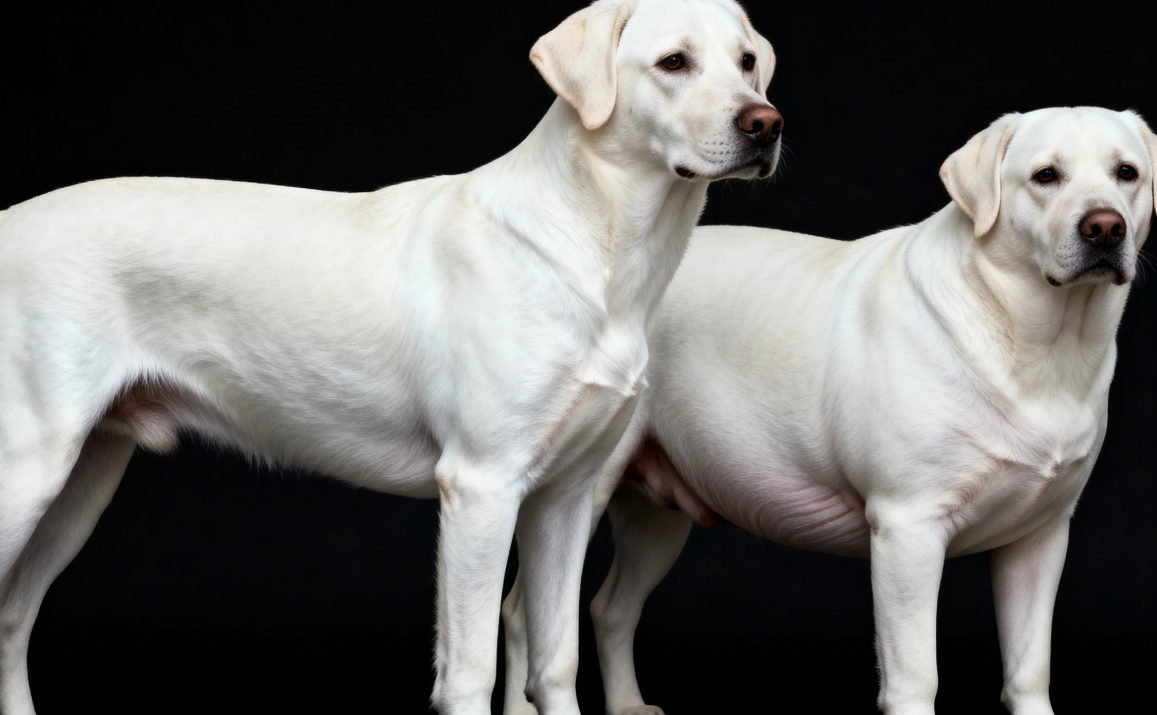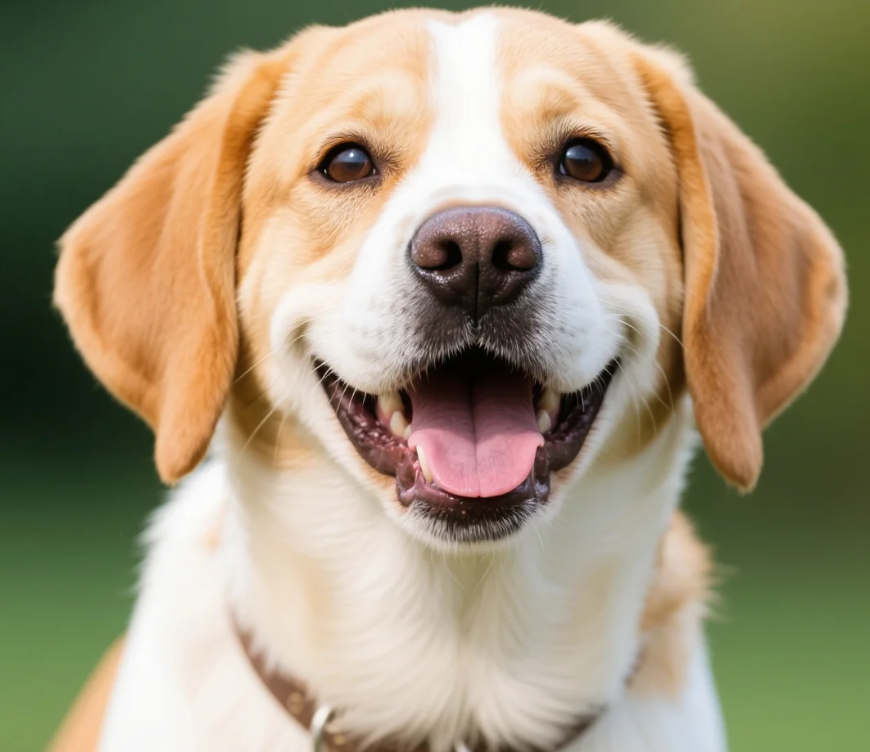How to Tell If Your Dog Is Fat: A Complete Pet Parent’s Guide
How to tell if your dog is fat is one of the most common questions American pet parents ask. We all love our furry friends, and a little extra fluff can look cute. But in reality, more than half of dogs in the U.S. are overweight, and those extra pounds can lead to serious health problems like arthritis, diabetes, and even a shorter lifespan.

Healthy (left) vs overweight (right) dog body shape reference
This article will give you clear signs to recognize dog obesity, practical steps to manage your pup’s weight, and emotional insights to help you give your best friend the long, healthy life they deserve.
1. Why Knowing How to Tell If Your Dog Is Fat Matters
Before diving into the signs, let’s understand why weight matters so much:
- Joint health: Extra weight puts strain on hips, knees, and spine.
- Heart and lung function: Fatigue and difficulty breathing are common in overweight dogs.
- Diabetes risk: Just like in humans, obesity is a leading cause of canine diabetes.
- Quality of life: Slim dogs run, play, and stay energetic much longer.
- Longevity: Studies show overweight dogs can live up to two years less.
More than 56% of domestic dogs in the U.S. are overweight or obese, but only 22% of pet parents recognize their dog has a weight problem.
By learning how to tell if your dog is fat, you’re not just checking appearance—you’re protecting their future.
🦴
2. Signs of an Overweight Dog
Underweight
Ribs stick out sharply; visible spine and hip bones
Ideal Weight
Ribs felt easily; clear waistline from above
Overweight
Ribs hard to feel; no visible waistline
🔍 The Rib Test
The rib test is one of the easiest and most reliable ways to check your dog’s weight at home. Here’s how to do it:
- Run your hands along your dog’s sides (with light pressure).
- You should feel the ribs without pressing hard—like feeling the back of your hand through a thin shirt.
- If you can’t feel them at all, your dog is likely overweight.
- If ribs stick out sharply, your dog may be underweight.
🔍 Look for a Waistline
Stand above your dog and check their body shape from two angles:
- From above: A healthy dog shows an hourglass figure; an overweight dog looks more oval or barrel-shaped (no waist indentation).
- From the side: You should see a “tuck-up” from the chest to the belly (a slight inward curve)—overweight dogs have a flat or rounded belly line.
🔍 Watch Their Energy Levels
Overweight dogs often show noticeable changes in activity. Look for these signs:
- Get tired quickly after short walks (e.g., stopping to rest after 10 minutes).
- Struggle to climb stairs or jump into the car (avoiding high surfaces they used to access easily).
- Sleep more and show less interest in playtime (ignoring toys or games they once loved).
While age can influence activity, sudden changes (e.g., a 3-year-old dog refusing walks) often link to weight gain.
🔍 Behavior Around Food
Dogs love food, but these behaviors signal potential weight issues:
- Constant begging for treats (even after meals, following you around the kitchen).
- Weight gain even when eating “normal” portions (no change in food amount but steady weight increase).
- Sneaky food stealing (e.g., raiding the trash, counter-surfing, or stealing other pets’ food).
🔍 Compare to Breed Standards
Check the AKC (American Kennel Club) breed weight chart for your dog’s breed. For example:
- Small breeds (e.g., Chihuahua): 2–6 lbs (ideal adult weight).
- Medium breeds (e.g., Beagle): 20–30 lbs (ideal adult weight).
- Large breeds (e.g., Labrador Retriever): 55–80 lbs (ideal adult weight).
Keep in mind: individual metabolism and bone structure matter—some dogs are naturally stockier than others.
🔍 Consult Your Veterinarian
Vets use a Body Condition Score (BCS) to assess weight objectively. The scale ranges from 1 (severely underweight) to 9 (severely obese):
- 1–3 = underweight
- 4–5 = ideal
- 6–9 = overweight/obese
Your vet can also rule out medical causes of weight gain, like hypothyroidism (an underactive thyroid gland).
🐾 Is Your Dog Overweight? Take the Quick Test
Can’t feel your dog’s ribs without pressing hard?
No visible waistline when looking from above?
Belly is flat or rounded (no tuck-up from the side)?
Your dog gets tired quickly during walks or play?
Your dog has gained 10%+ of their ideal weight in 6 months?
If you checked 2+ items: Talk to your vet about a weight management plan!

Regular exercise (like fetch) helps maintain a healthy dog weight
🦴
3. What to Do If Your Dog Is Fat
If you’ve figured out how to tell if your dog is fat and realized your pup is overweight, here’s how to take action—slowly and sustainably (crash diets harm dogs!).
🥗 Adjust Their Diet
- Measure portions instead of free-feeding: Use a measuring cup to avoid overfeeding (follow food bag guidelines, but adjust for your dog’s activity level—less active dogs need fewer calories).
- Use low-calorie treats sparingly: Swap high-calorie biscuits for carrot sticks, green beans, or commercial low-fat treats (limit treats to 10% of daily calories).
- Choose high-protein, nutrient-rich dog food: Protein keeps dogs full longer and preserves muscle mass (avoid foods with excessive fillers like corn or wheat—check the ingredient list for real meat first).
🏃 Boost Their Exercise
Start slow—especially if your dog is out of shape. Try this simple weekly plan:
- Daily walks: Begin with 20–30 minutes, twice a day. Gradually increase time by 5 minutes each week as your dog builds stamina.
- Interactive play: Fetch, tug-of-war, or puzzle feeders (mental stimulation also burns calories—keep your dog engaged for 15–20 minutes daily).
- Low-impact exercise: Swimming is great for older dogs or those with joint issues (it’s easy on hips and knees—aim for 10–15 minutes per session).
🔍 Track Their Progress
Consistency is key—track progress to stay motivated:
- Weigh monthly: Use the same scale at home, or weigh during vet visits (dogs should lose 1–2% of their body weight per week—faster weight loss risks muscle loss).
- Take “before and after” photos: Visual changes are often more noticeable than numbers on a scale (e.g., a clearer waistline after 2 months).
- Reward with affection instead of food: Praise, belly rubs, or extra playtime work better than treats—strengthen your bond without extra calories!
🦴
4. Preventing Obesity in Dogs
The best cure for dog obesity is prevention. Here are simple steps every pet parent can follow:
- Feed on a schedule: Stick to 2–3 meals a day (depending on age) instead of leaving food out 24/7—prevents mindless overeating.
- Avoid human table scraps: Scraps like cheese, bacon, or bread add hidden calories (a single slice of bread is ~10% of a small dog’s daily calorie needs!).
- Stay consistent with exercise: Don’t skip walks in winter—bundle up and go short, or play indoor games like hide-and-seek (hide treats around the house for mental and physical activity).
- Visit your vet regularly: Annual checkups let your vet catch weight gain early, before it becomes a problem—your vet can also adjust diet and exercise plans as your dog ages.
🦴
5. Emotional Side of Dog Obesity
Dogs don’t understand “dieting”—they just know they love you and associate food with affection. That’s why weight management isn’t just about discipline—it’s about redefining how you show love.
Think about it this way:
- Every skipped walk is a missed adventure (your dog doesn’t care about the weather—they care about time with you).
- Every extra treat could shorten the years you have together (obesity cuts lifespan by up to 2 years).
- Every healthy choice means more play, more cuddles, and more life (a slim dog has the energy to chase balls and snuggle on the couch).
As pet parents, keeping them healthy is one of the best ways to return the unconditional love they give us every day.
🦴
6. Final Thoughts
Knowing how to tell if your dog is fat is more than an appearance check—it’s a vital part of being a responsible pet parent. By using the rib test, checking waistlines, monitoring energy levels, and consulting your vet, you’ll be able to catch weight problems early and act fast.
Your dog depends on you to make the right choices. Helping them maintain a healthy weight means more joy, more years, and more memories together. And isn’t that the ultimate goal for every pet parent?
🐾

One Response